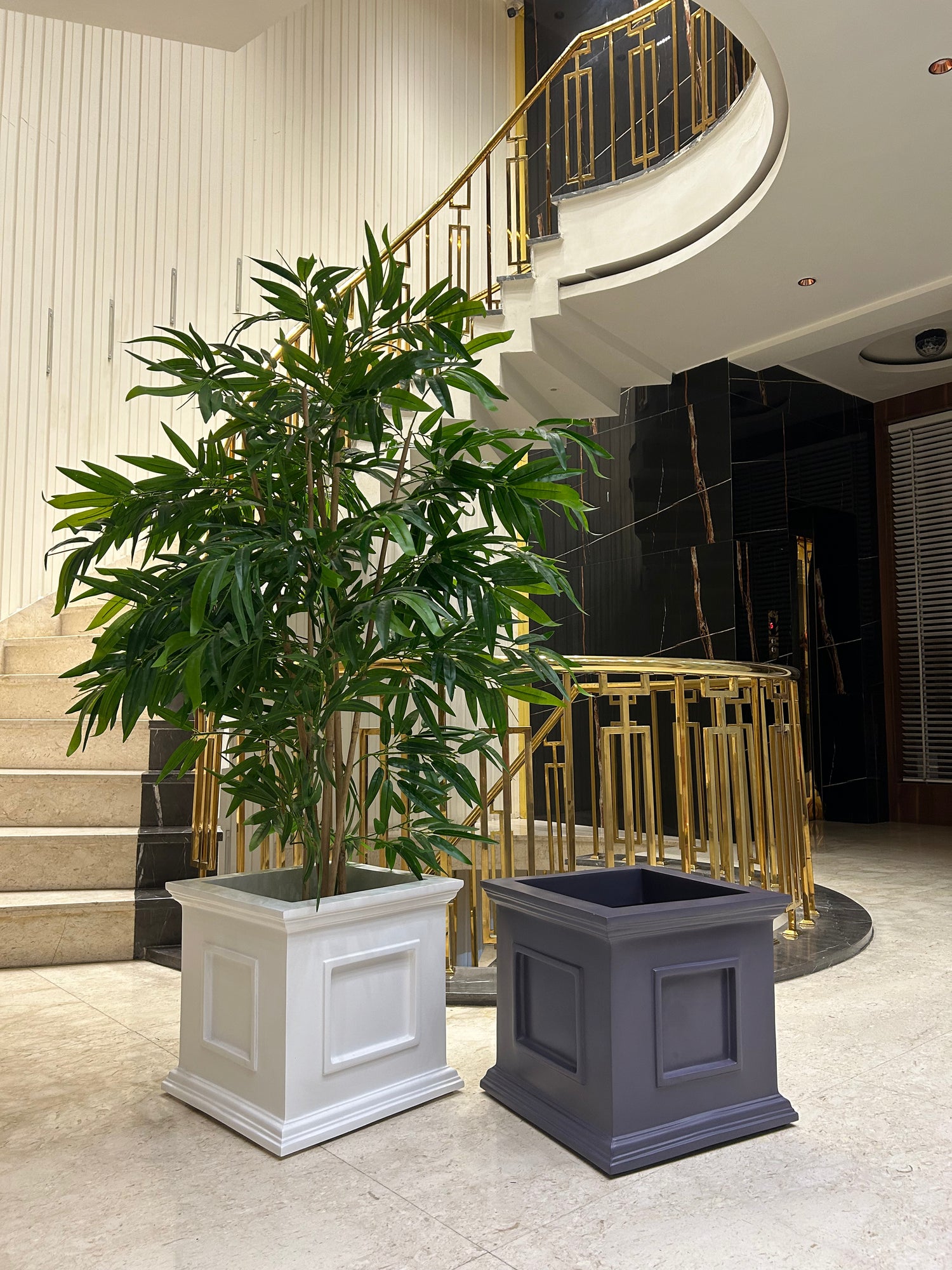
How to Choose the Right Planter for Your Plant
Share
Choosing the right planter is more than just a design decision—it's a key factor in your plant’s health and growth. A mismatched pot can stifle your plant’s roots, overhydrate its soil, or detract from your garden’s aesthetics. Whether you’re curating an indoor jungle or designing a lush outdoor landscape, understanding how to select the perfect planter is crucial. In this guide, we’ll explore planter materials, sizes, drainage, and styles, focusing especially on the versatility of fiberglass planters, a modern gardener’s favorite.
Why the Right Planter Matters
Selecting a planter is about balancing style and function. The planter should complement your plant’s growth requirements while also aligning with your decor—indoors or outdoors. For instance:
- Improper Size: A planter too small will restrict root growth, while one too large can lead to waterlogging.
- Poor Drainage: No drainage holes can drown your plant, while too many might leave it dry.
- Unsuitable Material: A planter’s material can influence its weight, durability, and insulation.
Fiberglass planters, with their lightweight design and weather resistance, are a standout choice, but each plant demands careful consideration.
Understanding Planter Essentials
When selecting a planter, consider these four main factors:
1. Material Matters
Planters come in a variety of materials, each with its own pros and cons:
| Material | Benefits | Drawbacks |
|---|---|---|
| Fiberglass Planters | Lightweight, durable, stylish, weather-resistant | More expensive than plastic pots |
| FRP Planters | Sturdy, eco-friendly, UV-resistant | Can be pricier than traditional materials |
| Terracotta | Affordable, classic look, porous | Fragile, dries soil quickly |
| Ceramic | Attractive designs, great for indoors | Heavy, can be expensive |
| Plastic | Affordable, lightweight | Not as durable, less aesthetic appeal |
Tip: For outdoor planters exposed to the elements, opt for weather-resistant materials like fiberglass or FRP.
2. Size and Scale
Plants need room to grow, but they also thrive when snug in appropriately sized pots.
- Small planter pots are ideal for succulents and herbs.
- Medium pots accommodate houseplants like pothos and peace lilies.
- Biggest planter pots are perfect for trees and large statement plants.
Quick Sizing Guide:
| Plant Type | Recommended Planter Size |
|---|---|
| Herbs (e.g., basil, thyme) | 4–6 inches (small planter pots) |
| Snake plants, Pothos | 8–12 inches (medium planters) |
| Fiddle leaf fig, Palms | 16+ inches (biggest planter pots) |
3. Drainage is Key
Good drainage prevents overwatering, a common killer of houseplants. Here’s how to ensure your planter meets this need:
- Look for drainage holes at the bottom.
- Use a layer of pebbles if the pot lacks holes.
- Consider self-watering planters for busy lifestyles.
4. Style and Design
Your planter should reflect your personal taste while enhancing the plant's natural beauty. Modern fiberglass planters or minimalist FRP planters can create a sleek, contemporary vibe indoors or outdoors.
Choosing Planters for Indoor and Outdoor Spaces
Indoor Garden Pots
Indoor planters are all about blending function with interior design.
- Use fiberglass planters for their modern appeal and durability.
- Try self-watering pots for plants like peace lilies.
- Opt for small planter pots for tabletops and windowsills, paired with succulents or herbs.
Example: A sleek white fiberglass planter housing a snake plant can be a perfect centerpiece in a modern living room.
Outdoor Planters
Outdoor environments demand planters that can withstand weather changes.
- FRP planters are excellent for UV resistance and eco-friendliness.
- Choose fiberglass planters for lightweight flexibility and weather resistance.
- Incorporate biggest planter pots for trees or large flowering plants to create striking focal points.
Tip: Group small and medium planters with colorful blooms on balconies for a layered effect.
Comparing Fiberglass and FRP Planters
| Feature | Fiberglass Planters | FRP Planters |
|---|---|---|
| Durability | Highly durable | Extremely sturdy |
| Weight | Lightweight | Slightly heavier than fiberglass |
| Style Options | Sleek, modern designs | Wide range, often contemporary |
| Weather Resistance | Excellent for outdoor and indoor use | Excellent for harsh weather conditions |
| Eco-Friendliness | Moderately eco-friendly | Highly eco-friendly |
Pro Tip: Use FRP planters for a sustainable option when creating a modern outdoor landscape, especially for plants like palms or large ferns.
Matching Planters to Plant Sizes
Small Planter Pots
Ideal for compact plants like:
- Herbs: Basil, thyme, mint
- Succulents: Echeveria, haworthia
Medium Planters
Perfect for versatile houseplants like:
- Pothos
- Snake plants
- Peace lilies
Biggest Planter Pots
Designed for statement plants like:
- Fiddle leaf figs
- Rubber plants
- Outdoor palms
Actionable Tips for Planter Success
- Repot Regularly: Check for root-bound plants and upsize accordingly.
- Mix and Match: Combine textures like fiberglass and terracotta for a layered design.
- Accessorize: Add decorative stones or moss for a polished look.
Conclusion
The right planter is not just a container; it’s a vital partner in your plant’s health and a key decor element. Whether you’re designing an indoor oasis with fiberglass planters or creating a robust outdoor garden with FRP planters, your choices can transform your space.
So, why wait? Start exploring the world of planters and watch your garden thrive! Share your favorite planter setups or ideas in the comments below—I’d love to hear from you!
Let’s elevate your gardening journey, one planter at a time. 🌱



